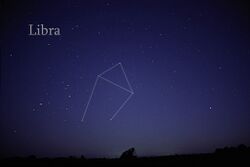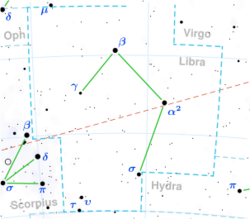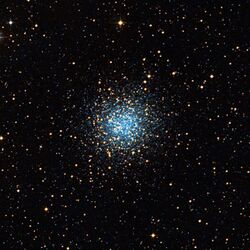Libra (constellation)
Topic: Astronomy
 From HandWiki - Reading time: 8 min
From HandWiki - Reading time: 8 min
| Constellation | |
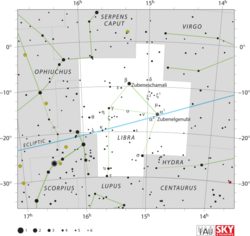 | |
| Abbreviation | Lib |
|---|---|
| Genitive | Librae |
| Pronunciation | /ˈliːbrə/, genitive /ˈliːbriː/ |
| Symbolism | the balance |
| Right ascension | 15h |
| Declination | −15° |
| Quadrant | SQ3 |
| Area | 538 sq. deg. (29th) |
| Main stars | 4, 6 |
| Bayer/Flamsteed stars | 56 |
| Stars with planets | 4 |
| Stars brighter than 3.00m | 2 |
| Stars within 10.00 pc (32.62 ly) | 5 |
| Brightest star | Beta Librae (β Lib) (2.61m) |
| Messier objects | 0 |
| Meteor showers | May Librids |
| Bordering constellations | Serpens Caput Virgo Hydra Centaurus (corner) Lupus Scorpius Ophiuchus |
| Visible at latitudes between +65° and −90°. Best visible at 21:00 (9 p.m.) during the month of June. | |
Libra /ˈliːbrə/ is a constellation of the zodiac and is located in the Southern celestial hemisphere. Its name is Latin for weighing scales. Its old astronomical symbol is ![]() (♎︎). It is fairly faint, with no first magnitude stars, and lies between Virgo to the west and Scorpius to the east. Beta Librae, also known as Zubeneschamali, is the brightest star in the constellation. Three star systems are known to have planets.
(♎︎). It is fairly faint, with no first magnitude stars, and lies between Virgo to the west and Scorpius to the east. Beta Librae, also known as Zubeneschamali, is the brightest star in the constellation. Three star systems are known to have planets.
Features
Stars
Overall, there are 83 stars within the constellation's borders brighter than or equal to apparent magnitude 6.5.[lower-alpha 1][2]
The brightest stars in Libra form a quadrangle that distinguishes it for the unaided observer. Traditionally, Alpha and Beta Librae are considered to represent the scales' balance beam, while Gamma and Sigma are the weighing pans.
Alpha Librae, called Zubenelgenubi, is a multiple star system divisible into two stars when seen through binoculars, The primary (Alpha2 Librae) is a blue-white star of magnitude 2.7 and the secondary (Alpha1 Librae) is a white star of magnitude 5.2 and spectral type F3V that is 74.9 ± 0.7 light-years from Earth. Its traditional name means "the southern claw". Zubeneschamali (Beta Librae) is the corresponding "northern claw" to Zubenelgenubi. The brightest star in Libra, Zubeneschamali is a green-tinged star of magnitude 2.6, 160 (or 185 ± 2) light-years from Earth. Gamma Librae is called Zubenelakrab, which means "the scorpion's claw", completing the suite of names referring to Libra's archaic status. It is an orange giant of magnitude 3.9, 152 light-years from Earth.[3]
Iota Librae is a complex multiple star, 377 light-years from Earth, with both optical and true binary components. The primary appears as a blue-white star of magnitude 4.5; it is a binary star indivisible in even the largest amateur instruments with a period of 23 years. The secondary, visible in small telescopes as a star of magnitude 9.4, is a binary with two components, magnitudes 10 and 11. There is an optical companion to Iota Librae; 25 Librae is a star of magnitude 6.1, 219 light-years from Earth and visible in binoculars. Mu Librae is a binary star divisible in medium-aperture amateur telescopes, 235 light-years from Earth. The primary is of magnitude 5.7 and the secondary is of magnitude 6.8.[3]
Delta Librae is an Algol-type eclipsing variable star, 304 lightyears from Earth. It has a period of 2 days, 8 hours; its minimum magnitude of 5.9 and its maximum magnitude is 4.9. FX Librae, designated 48 Librae, is a shell star of magnitude 4.9. Shell stars, like Pleione and Gamma Cassiopeiae, are blue supergiants with irregular variations caused by their abnormally high speed of rotation. This ejects gas from the star's equator.[3]
Sigma Librae (the proper name is Brachium[4]) was formerly known as Gamma Scorpii despite being well inside the boundaries of Libra. It was not redesignated as Sigma Librae until 1851 by Benjamin A. Gould.
History and mythology
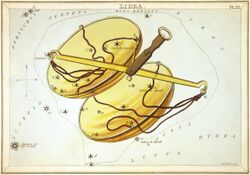
Libra was known in Babylonian astronomy as MUL Zibanu (the "scales" or "balance"), or alternatively as the Claws of the Scorpion. The scales were held sacred to the sun god Shamash, who was also the patron of truth and justice.[5]
It was also seen as the Scorpion's Claws in Ancient Greece .[3] Since these times, Libra has been associated with law, fairness and civility. In Arabic zubānā means "scorpion's claws", and likely similarly in other Semitic languages: this resemblance of words may be why the Scorpion's claws became the Scales.[citation needed] Indeed, Zubenelgenubi and Zubeneschamali, the names of the constellation's two main stars, in Arabic mean "southern claw" and "northern claw" respectively. It has also been suggested that the scales are an allusion to the fact that when the sun entered this part of the ecliptic at the autumnal equinox, the days and nights are equal.[6] Libra's status as the location of the equinox earned the equinox the name "First Point of Libra", though this location ceased to coincide with the constellation in 730 BC because of the precession of the equinoxes.
In ancient Egypt the three brightest stars of Libra (α, β, and σ Librae) formed a constellation that was viewed as a boat.[7] Libra is a constellation not mentioned by Eudoxus or Aratus.[6] Libra is mentioned by Manetho (3rd century B.C.) and Geminus (1st century B.C.), and included by Ptolemy in his 48 asterisms. Ptolemy catalogued 17 stars, Tycho Brahe 10, and Johannes Hevelius 20.[6] It only became a constellation in ancient Rome, when it began to represent the scales held by Astraea, the goddess of justice, associated with Virgo in the Greek mythology.[3]
The constellation
Libra is bordered by the head of Serpens to the north, Virgo to the northwest, Hydra to the southwest, the corner of Centaurus to the southwest, Lupus to the south, Scorpius to the east and Ophiuchus to the northeast. Covering 538.1 square degrees and 1.304% of the night sky, it ranks 29th of the 88 constellations in size.[2] The three-letter abbreviation for the constellation, as adopted by the International Astronomical Union in 1922, is "Lib".[8] The official constellation boundaries, as set by Eugène Delporte in 1930, are defined by a polygon of 12 segments (illustrated in infobox). In the equatorial coordinate system, the right ascension coordinates of these borders lie between 14h 22m 08.08s and 16h 02m 17.23s, while the declination coordinates are between −0.47° and −30.00°.[9] The whole constellation is visible to observers south of latitude 60°N.[lower-alpha 2]
Planetary systems
Libra is home to the Gliese 581 planetary system, which consists of the star Gliese 581, three confirmed planets, and two unconfirmed planets. Both Gliese 581d, and Gliese 581g are debatably the most promising candidates for life, although Gliese 581g's existences has been disputed and has not been entirely confirmed or agreed on in the scientific community.[10] Gliese 581c is considered to be the first Earth-like extrasolar planet to be found within its parent star's habitable zone. Gliese 581e is possibly the smallest mass exoplanet orbiting a normal star found to date[11] All of these exoplanets are of significance for establishing the likelihood of life outside of the Solar System.[12]
The family of candidate habitable planets was extended in late September 2010 to include exoplanets around red dwarf stars because of Gliese 581g, which is a tidally locked planet in the middle of the habitable zone. Weather studies show that tidally locked planets may still have the ability to support life.[13][14]
Deep-sky objects
Libra is home to one bright globular cluster, NGC 5897. It is a loose cluster, 50,000 light-years from Earth; it is fairly large and has an integrated magnitude of 9.[3] IC 1059 is a galaxy in the constellation Libra.[15]
Astrology
(As of 2002), the Sun appears in the constellation Libra from October 31 to November 22. In tropical astrology, the Sun is considered to be in the sign Libra from the northern autumnal equinox (c. September 23) to on or about October 23, and in sidereal astrology, from October 16 to November 15.
Namesakes
- Libra (AKA-12) was a United States navy ship named after the constellation.
- Tropical Storm Tembin - Four tropical cyclones in the western Pacific have been given its Japanese name.
See also
- Constellation family
- Former constellations
- Libra (Chinese astronomy)
- Lists of stars by constellation
Notes
- ↑ Objects of magnitude 6.5 are among the faintest visible to the unaided eye in suburban-rural transition night skies.[1]
- ↑ While parts of the constellation technically rise above the horizon to observers between 60°N and 89°N, stars within a few degrees of the horizon are to all intents and purposes unobservable.[2]
References
- ↑ Bortle, John E. (February 2001). "The Bortle Dark-Sky Scale". Sky & Telescope. Sky Publishing Corporation. http://www.skyandtelescope.com/resources/darksky/3304011.html?page=1&c=y.
- ↑ 2.0 2.1 2.2 Ridpath, Ian. "Constellations: Lacerta–Vulpecula". Star Tales. Self-published. http://www.ianridpath.com/constellations2.html.
- ↑ 3.0 3.1 3.2 3.3 3.4 3.5 Ridpath & Tirion 2001, pp. 172-173.
- ↑ "Naming Stars". IAU.org. https://www.iau.org/public/themes/naming_stars/.
- ↑ Babylonian Star-lore by Gavin White, Solaria Pubs, 2008, page 175
- ↑ 6.0 6.1 6.2
 This article incorporates text from a publication now in the public domain: Chisholm, Hugh, ed (1911). "Libra". Encyclopædia Britannica (11th ed.). Cambridge University Press.
This article incorporates text from a publication now in the public domain: Chisholm, Hugh, ed (1911). "Libra". Encyclopædia Britannica (11th ed.). Cambridge University Press.
- ↑ Priskin, Gyula. "The Astral Myth of Osiris: the Decans of Taurus and Libra". http://www.enim-egyptologie.fr/index.php?page=enim-9&n=7.
- ↑ Russell, Henry Norris (1922). "The New International Symbols for the Constellations". Popular Astronomy 30: 469. Bibcode: 1922PA.....30..469R.
- ↑ "Libra, Constellation Boundary". The Constellations (International Astronomical Union). https://www.iau.org/public/themes/constellations/#lib. Retrieved 3 April 2016.
- ↑ Shiga, David (September 29, 2010), Found: first rocky exoplanet that could host life, New Scientist, https://www.newscientist.com/article/dn19519-found-first-rocky-exoplanet-that-could-host-life.html, retrieved September 30, 2010
- ↑ Mayor, Michel; Bonfils, Xavier; Forveille, Thierry et al. (2009). "The HARPS search for southern extra-solar planets, XVIII. An Earth-mass planet in the GJ 581 planetary system". Astronomy and Astrophysics 507 (1): 487–494. doi:10.1051/0004-6361/200912172. Bibcode: 2009A&A...507..487M. http://obswww.unige.ch/~udry/Gl581_preprint.pdf.
- ↑ "Major Discovery: New Planet Could Harbor Water and Life". 24 April 2007. http://www.space.com/scienceastronomy/070424_hab_exoplanet.html.
- ↑ "Department of Astronomy". http://www.astro.washington.edu/users/jrad/521.pdf.
- ↑ "Earth-Like Planet Can Sustain Life : Discovery News". Discovery Channel. 2010-09-29. http://news.discovery.com/space/earth-like-planet-life.html.
- ↑ csligman.com
Sources
- Ridpath, Ian; Tirion, Wil (2001), Stars and Planets Guide, Princeton University Press, ISBN 0-691-08913-2
- Ian Ridpath and Wil Tirion (2007). Stars and Planets Guide, Collins, London. ISBN:978-0-00-725120-9. Princeton University Press, Princeton. ISBN:978-0-691-13556-4.
External links
| Wikimedia Commons has media related to: |
- The Deep Photographic Guide to the Constellations: Libra
- Libra constellation
- Ian Ridpath's Star Tales – Libra
- Warburg Institute Iconographic Database (medieval and early modern images of Libra)
Coordinates: ![]() 15h 00m 00s, −15° 00′ 00″
15h 00m 00s, −15° 00′ 00″
 |
 KSF
KSF